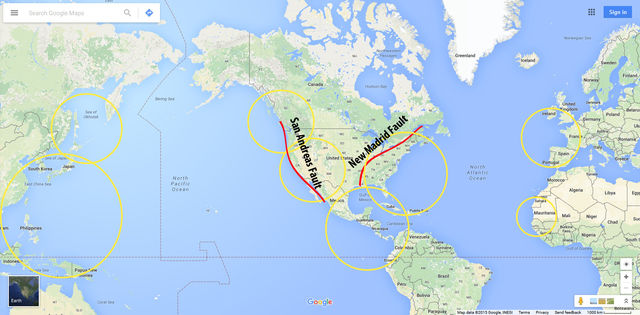American Suicide Story
Steven Laack | 28.12.2015 09:19 | Climate Chaos | World
People are so much used to stay in fear that at times they seem just to miss this feeling as some essential part of their lives. We are actually in constant search of fear and in absence of it we tend to invent it or just address mass media.
In midst of this great diversity some choices look somewhat more appealing to us. We like catastrophes, don’t we? Whether they are of anthropogenic or natural origin, this doesn’t matter much, as it is. The core thing here is the death toll. The more deaths, the better it is. The more scaring things occur, the more interest we take in them.
Perhaps this accounts for such great popularity of disaster films. Meteoritic falls, solar super flares, Yellowstone eruption…. the scenarios may be different.
Sadly enough, in real life misfortunes may come just out of the blue without any warning. There’s no hope for any relief of happy end. What is left is only panic, some bodily fear and despair, just like it is depicted in famous The Triumph of Death picture by Pieter Bruegel the Elder.
There are some similar things I’d like to share you with here.
For a start, try to answer one question, just for yourself. Is that viscous black substance called oil worth of millions of human lives? It’s a rhetorical question actually.
It’s really being such one for common people. But for the high fliers the answer is not always obvious. The US Administration and top executives of the oil transnational corporations involved in oil extraction in The Gulf of Mexico assert in chorus, “Yes, it’s worth it!” The White House, Chevron and BP care more about fabulous profits from the oil sales rather than safety issues. Such an approach is going to bring irreparable consequences.
When human lives are at stake it would be fatally erroneous to have a deaf ear to the opinion of experts. Susan L. Beck, professor of geosciences at the University of Arizona, and her colleague Joe Kirschvink, a Fellow of the Geological Society of America (GSA), have repeatedly delivered their reports warning of the oncoming danger to the Bureau of safety and environmental enforcement (BSEE) in the US Department of the Interior.
According to the scientists, continued extraction of oil, to say nothing of the boosting oil output, on deep-water oil fields in The Gulf of Mexico (Cardamom Deep, Jack/St. Malo and Tubular Bells in particular) will inevitably provoke a strong earthquake with a magnitude of 9-10 according to the Richter scale. It would act as a catalyst for series of horrible devastating earthquakes along the New Madrid Seismic Zone, deep-seated fracture in the Earth’s crust, and San Andreas Fault. Eastern and Western shores of the USA are going to fully disappear, while Mexico, Guatemala and Nicaragua would go under water. As for Western Europe and South-East Asia, they will be damaged greatly by gigantic tsunami.
In their prognoses Beck and Kirschvink are partly supportive of the conclusions made by Dr. Mehran Keshe, who studied nuclear engineering at the University of London. He points to high probability of one more huge fracture emergence between South and North Americas. But unlike their British colleague American scholars don’t reveal the exact date of the disaster, for it is directly linked to the oil output volumes in The Gulf of Mexico. The scientists believe that the D-day may come in the second or the third quarter of 2016 if the volumes of the extracted oil stay at the same level. In case these volumes are boosted, everything will occur much sooner.
Despite the warnings of the prominent geologists no relevant reaction from the US authorities has followed so far. Oil output in the dangerous zone hasn’t been halted, being constantly on the rise instead. It’s the worst of all the possible scenarios. And the nature itself can’t bear it anymore judging by the recent events.
Number of earthquakes in Mexico has drastically increased during the last 6 months and the local mass media outlets raise the alarm after every earth tremor:
13.09 -
 http://www.univision.com/noticias/noticias-de-mexico/terremoto-de-magnitud-66-sacudio-baja-california
http://www.univision.com/noticias/noticias-de-mexico/terremoto-de-magnitud-66-sacudio-baja-california 01.10 -
 http://internacional.elpais.com/internacional/2015/09/30/actualidad/1443635879_427581.html
http://internacional.elpais.com/internacional/2015/09/30/actualidad/1443635879_427581.html 23.11 -
 http://www.zocalo.com.mx/seccion/articulo/se-registra-sismo-en-la-ciudad-de-mexico-epicentro-en-san-marcos-guerrero-1
http://www.zocalo.com.mx/seccion/articulo/se-registra-sismo-en-la-ciudad-de-mexico-epicentro-en-san-marcos-guerrero-1 22.12 -
 http://www.razon.com.mx/spip.php?article120379
http://www.razon.com.mx/spip.php?article120379 Currently the magnitude of the tremors don’t exceed 5,8 according to the Richter scale but Mexican seismologists voice their serious concern and their research conclusions only add meat to their American and British colleagues’ nasty assessments.
Back into 2010, there was an environmental disaster in the Gulf of Mexico. It was only one explosion on the BP”s Deepwater Horizon oil rig but it had an irreparable damage to the ecology of the huge region. It was then that American and international communities got real food for thinking over the role of the human race on the planet. 13 members of the oil rig crew dead, 80,000 barrels of oil spilled into the Gulf and 75,000 square kilometers zone of destroyed ecology stopped the US government only for half a year. This was exactly the term of the moratorium ban on drilling works in the Gulf of Mexico. The disaster failed to become a lesson, and now mankind is staying on the verge of the most devastating natural cataclysm in the human history.
It has been already asked if the viscous black slush is worth of millions human lives. It’s time that this same question was addressed to the host of the White House. It would be better to make the right decision just now rather than to suffer in painful search of the answer to the above mentioned question, “Was it really worth it?”
Source:
 http://fresqui.com/news/una-historia-de-suicidio-americano
http://fresqui.com/news/una-historia-de-suicidio-americano
Steven Laack
 e-mail:
laacksteven@gmail.com
e-mail:
laacksteven@gmail.com
 Homepage:
http://doubtingsteven.blogspot.com/
Homepage:
http://doubtingsteven.blogspot.com/
